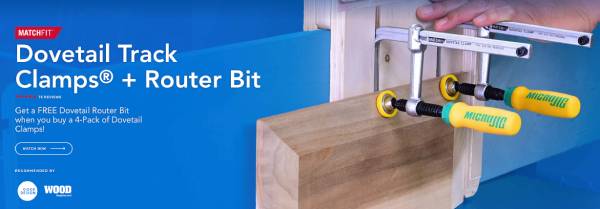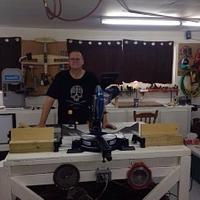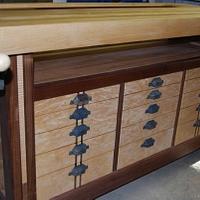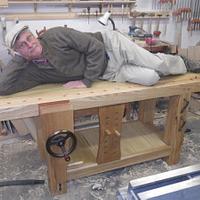9 Replies
A workbench is basically made to hold workpieces and because of the many different sizes and shapes and the types of work being performed on them, a lot of different holding options are not only desirable but also necessary, That is unless you are doing more or less repetitious work building the same type of stuff all the time. A bench should also be very steady under a heavy workload, such as planing for instance. My best tip is explore the many different types of benches that have proven themselves useful, try to relate your own needs to how the different ones would work for you, but try to think of the future too, when new skills might translate to other types of work. Check prices on what you want so you can evaluate whether to buy or make one with a view towards getting the most for your money. I have ‘The Workbench Book’ by Scott Landis which I have had a few years and which I still enjoy reading. I used a lot of ideas from it for my own bench which I am extremely happy with. I built it fairly recently and it has made my woodworking much, much more enjoyable.
Mike, an American living in Norway
Decide on and buy or build your vises before you begin anything other than preliminary design. That way they can be designed in instead of retrofit, which could be undesirable. I guess the same goes for any features, but to me it seems particularly important for vises.
Losing fingers since 1969
I agree with both, and, would like to add a few tips. Make a plan from start to finish of all the things that need to be done in what order. That may force you to make decisions before even drawing, but that’s a good thing it’ll make the build go smoothly. Once you have the plan then make a list of everything you will need and then make or buy a detailed plan or blueprint. Try to think of all the things you have wished you have needed or wanted a bench for and get those incorporated into the design. Most of the building tasks are basic carpentry skills, but if you haven’t done a particular task before, research it, then practice on some scrap. Mostly, enjoy building the one tool that you will use on every project forever and have fun doing it.
CHRIS, Charlottetown PEI Canada. Anytime you can repurpose, reuse, or recycle, everyone wins!
Some good points where made but I would like to add some from what I have found .
First of what kind of bench, *a Show bench or a Work bench *cost is also a consideration and can add up what kind of vise, hight ?
I use my bench daily and use it without worry about scratching it or or marking it with a tool but find ways to improve it as the need arises and develop new clamping devices .
I started out buiding a work centre around my table saw and it workes ok but found there was a need for a workbench and had to find a way in the shop space that I have avalible .My bench is made from construction grade lumber and has an 5 1/2 "thick top and is nice and heavy, the vises are my designs that I have developed and built from common materials .The leg vise is a quick release type with a class one lever action and operated with a footpedal which makes clamping my workpiece much easyier as both my hands are free and my foot does the clamping operation .
The end vise is a twin screw belt drive which I also made but took the design one step further by adding a tail vise that is operated by the end vise .
I guess what I am trying to add is that a bench is a tool that will develop over time as your needs change .
I have made several videos that explain the path I took much better then I can put into writing and you can watch them at this link .
Klaus
Building a bench starts with choosing a design, which can be confusing and/or overwhelming due to the multitude of info/books written about different benches. Bench height, vise placement, round vs. square dog holes, size and thickness of the top etc. are all considerations. Experience is invaluable here. If this is someone’s very first bench, my advice would be to build something cheap and simple, use it for a few years and decide what you like and don’t like about it and base your ultimate bench design on it, rather than picking the shiniest roubo design and building it based on what others have said you need.
My first bench was a simple design from FWW made of plywood with a small front vise. When I eventually had the time and money to build a real bench, I knew what I wanted based on my experience (thick front apron, small tail vise, bench as thick and heavy as I could make it, no tool well, no sliding deadman etc.)
Rob, Sault Ste. Marie, Ontario
Not mentioned above is the finish, once you get past the myriad of other details on the actual construction. To me, having a film finish on a workbench is just building in complications. As it gets damaged,flakes, peels, or whatever, you’re faced with repair or refinish. A better choice (IMHO) is a finish that has none of those detriments: to me, that’s using a mixture of beeswax (or parrifin), some solvent for the beeswax (turp or MS) and some BLO. The advantage of this finish is that to repair you simply wipe a new coat on top of the old coat. It doesn’t flake or peel, and best of all: glue pops right off.
"I long for the day when coke was a cola and a joint was a bad place to be" Merle Haggartd
More on the finish- I used BLO on top and WOP on the rest. The top gets the use /abuse. Incorporate features that help your style of work and what you build. i looked at a lot of styles of benchs and then made mine to fit me.
Make the front legs flush with the top. It makes clamping big stuff like doors to the front of the bench a lot easier.
Bondo Gaposis
I agree with bondo I plan on building a new workbench and that’s a good idea making one side or both with legs even with the edge of the top for being able to clamp big pcs to the side of it. In my opinion a bench is just a really big tool depending on what type of work you plan on doing. You don’t need a bench with a 6 inch thick top and motice and tenon joints for just a basic work table but… if your going to be pounding or want something you can put small power tools on and don’t want it bouncing plan accordingly by all means.
I’ve always felt you can never go wrong over building a little more than you think you might need
Mark DellaCamera

















